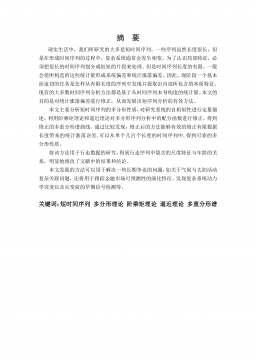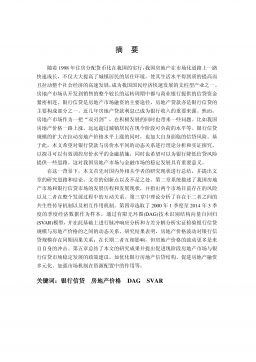通风型太阳能光伏多层外墙热湿耦合传递及调湿效果研究
VIP免费
摘要
随着社会的进步,建筑外墙在不断的发展,但依然还存在一些问题,如墙体
的隔热性、蓄热性以及墙体蓄放湿性能没有得到很好的利用,因此有必要对目前
采用的常规建筑外墙进行改进,通过设计合理的墙体结构并选用合适的建筑材料
来达到节能的目的,以及改善室内舒适性,并且需要研究墙体自身的热湿耦合传
递规律及墙体对室内热湿环境的影响。
首先,为了达到隔热、排湿、调节室内湿环境的效果,本文设计了一种通风
型太阳能光伏多层外墙结构,将光伏组件与轻质蒸压加气混凝土结合起来,在内
表面采用内保温和 MgO 调湿材料,并在墙体内设置通风层。光伏板及其背后的通
风层在夏季可以起到减少太阳辐射得热的作用,保温层起到隔热的作用,MgO 调
湿材料起到调节室内湿环境的作用。
其次,为了研究通风型太阳能光伏多层外墙热湿耦合传递规律及对室内环境
的影响,设计和搭建了实验系统,包括测试房和对比房两个房间。通过测试过渡
季节和冬季条件下,所设计的外墙与普通外墙的温度、湿度、热流等参数,得出
以下结论:(1)、使用通风型太阳能光伏多层外墙的测试房在过渡季节相对于普通
房室内温度和相对湿度全天波动较小,含湿量较低;(2)、冬季时测试房室内温度
较高、相对湿度较低,但含湿量较大,体现了测试房较好的室内舒适性;(3)、光
伏组件在过渡季节能够减小室外综合温度,比普通墙体低 35.3%,并且墙体对于室
内的得热量,比普通墙体低 12.8%;(4)、在冬季带光伏组件的墙体能够减少热损
失,比普通墙体约低 49.9%;(5)、由于光伏组件的遮挡和通风流道的通风能够使
墙体更快的干燥,降低墙体内的相对湿度,减小了墙体内的湿积累;(6)、当室外
空气温度上升时,空气层内含湿量会迅速增大,但光伏背板流道的含湿量变化很
小,为空气层排湿风机的设计提供了实验依据。
再次,对轻质蒸压加气混凝土板及 MgO调湿材料进行热湿物性参数实验测试,
包括材料的等温湿平衡曲线以及水蒸气扩散系数,为求解热湿耦合传递模型提供
了基础;并且根据等温湿平衡曲线得到了 MgO 调湿材料在 35%-60%的平衡含湿量
为0.025g/g,相对于一般调湿材料具有较大的容湿量。
最后,采用 EnergyPlus 模拟软件建立了通风型太阳能光伏多层外墙在过渡季
节和冬季测试条件下的热湿耦合传递数值模拟模型,并与实验测试得到的室内热
湿环境及墙体温度进行对比验证,得到模拟结果与实验测试结果吻合较好,验证
了模拟方法的正确性;并且根据该热湿耦合数值模型,分别模拟了该外墙在夏季
和冬季工况下运用于上海、北京和广州时对室内热湿环境的影响,得到该外墙具
有较好的适用性。
关键词:围护结构 热湿传递 调湿材料 太阳能光伏
ABSTRACT
With the progress of the society, building external wall is constantly development,
but it still has some problems, such as the thermal insulation, heat storage and the
moisture sorption and desorption performance didn’t get to good use. Thus, it is
necessary to improve the structure of wall and based on new building materials to
reduce the energy consumption and improve the indoor comfort.
Firstly, a new type of multilayer external wall with photovoltaic panels and
ventilation channels is introduced in this paper. This wall integrate the photovoltaic
panels with light weight concrete, and use MgO based moisture buffering materials on
the internal surface, and there are two ventilation channels design between the
construction layers. The purpose of this design is to improve the insulation performance,
and ventilation channels can remove the moisture in the wall, besides, the MgO
moisture buffering materials can adjust the indoor relative humidity.
Then, in order to research the hydrothermal performance of the new wall structure
and the effect to the indoor environment, two contrast experiment house were built up,
which include test room and reference room. The south wall of the test room is
equipped with the new wall, and the reference room is equipped with light weight
concrete and EPS. This experiment is conducted in a series days in transition season and
winter season, and get the conclusions below:(1) the temperature and relative humidity
in the test room changed in a smaller range than in the reference room in the transition
season, and the moisture content also lower in the test room; (2) in winter season, the
temperature and moisture content in the test room is higher, but the relative humidity is
lower, which shows better indoor comfort;(3) the PV panels can reduce the
comprehensive temperature of outdoor in transition season, which is 35.3% lower than
the ordinary wall, and the heat gain in the test room is 12.8% lower than in the reference
room; (4) the heat loss is 49.9% lower than in the reference room in winter; (5) because
of the cover of PV panels and channel ventilation, it can reduce the relative humidity
and moisture accumulation in the wall; (6) when the temperature of outdoor air increase,
the moisture content in the air channel will increase rapidly, but it change less in the
channel behind the PV panel, this conclusion can as the design basis of fan in the air
channel to remove moisture.
In order to solve the heat and moisture transfer model, according to the standard of
ASTM, the light weight concrete and MgO moisture buffering materials are research to
determinate the isothermal sorption and water vapor permeability. According to the
experiment result, the equilibrium moisture content of MgO moisture buffering
materials between the relative humidity of 30%-65% is 0.025g/g, which is higher than
any other moisture buffering materials, and shows good moisture buffering
performance.
Finally, a heat and moisture transfer model of the multilayer external wall were
established based on EnergyPlus software, and the experimental weather data tested in
the transition season and winter season are as the calculation condition put into the
model. According to the comparison results of numerical and experimental data, they
agree well and so as to the numerical model was validated. Based on the simulation
model, the effect of the multilayer external wall to the thermal and moisture
environment when it used in Shanghai, Beijing and Guangzhou were simulated, and
conclude that the wall has a good applicability.
Key Word:Building envelops,Heat and moisture transfer,Moisture
buffering materials, Photovoltaic
目录
中文摘要
ABSTRACT
第一章绪论 ........................................................... 1
1.1 研究背景及意义 ................................................ 1
1.1.1 由于热湿传递引起的外墙与建筑能耗关系问题 ................... 1
1.1.2 由于热湿传递引起的外墙与结露及材料耐久性关系问题 ........... 2
1.1.3 由于热湿传递引起的外墙与室内舒适性关系问题 ................. 3
1.1.4 目前建筑外墙存在的问题 ..................................... 3
1.2 新型建筑外墙结构及材料研究现状 ................................ 4
1.2.1 太阳能光伏建筑一体化 ....................................... 4
1.2.2 外墙保温形式及材料 ......................................... 5
1.2.3 调湿材料 ................................................... 6
1.4 本文的主要研究内容 ........................................... 10
1.5 本章小结 ...................................................... 10
第二章通风型太阳能光伏多层外墙设计及实验方案 ........................ 12
2.1 通风型太阳能光伏多层外墙设计 ................................. 12
2.1.1 设计目的 .................................................. 12
2.1.2 外墙结构设计 .............................................. 13
2.1.3 外墙的运用 ................................................ 13
2.1.4 外墙的特点 ................................................ 14
2.2 实验系统 ..................................................... 15
2.2.1 对比实验房设计 ............................................ 15
2.2.2 墙体结构 .................................................. 19
2.2.3 太阳能光伏发电系统 ........................................ 22
2.2.4 实验数据采集系统 .......................................... 23
2.3 实验方案 ..................................................... 29
2.3.1 实验目的 .................................................. 29
2.3.2 实验工况及实验方法 ........................................ 29
2.3.3 实验测点布置 .............................................. 30
2.4 本章小结 ..................................................... 32
第三章实验数据处理与分析 ............................................ 33
3.1 实验房彩钢板保温性分析 ....................................... 33
3.1.1 数据处理方法 .............................................. 33
3.1.2 传热系数计算 .............................................. 34
3.2 通风型太阳能光伏多层外墙室内热湿环境研究 ..................... 34
3.2.1 过渡季节连续测试结果分析 .................................. 34
3.2.2 过渡季节晴天和阴天测试结果分析 ............................ 36
3.2.3 冬季连续测试结果分析 ...................................... 41
3.2.4 冬季晴天和阴天测试结果分析 ................................ 43
3.3 光伏组件对墙体温湿度分布的影响 ............................... 46
3.3.1 光伏组件对墙体传热的影响 .................................. 47
3.3.2 光伏组件对外墙得热量的影响 ................................ 48
3.3.3 光伏组件对墙体传湿的影响 .................................. 53
3.4 通风流道降温排湿效果实验研究 ................................. 56
3.4.1 光伏通风流道降温效果 ...................................... 56
3.4.2 墙体内空气层湿积累 ........................................ 57
3.5 本章小结 ..................................................... 60
第四章材料热湿物性参数研究 .......................................... 62
4.1 等温吸放湿曲线测试实验 ....................................... 62
4.1.1 实验原理 .................................................. 62
4.1.2 实验步骤 .................................................. 62
4.1.3 实验结果 .................................................. 64
4.2 水蒸汽扩散系数测试实验 ....................................... 67
4.2.1 实验原理 .................................................. 67
4.2.2 实验步骤 .................................................. 67
4.2.3 实验结果 .................................................. 68
4.3 本章小结 ..................................................... 69
相关推荐
-
七年级数学下册(易错30题专练)(沪教版)-第13章 相交线 平行线(原卷版)VIP免费
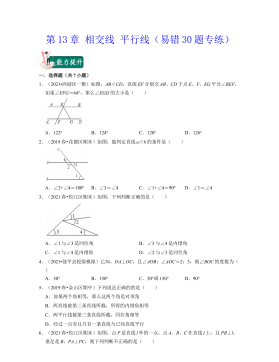
 2024-10-14 25
2024-10-14 25 -
七年级数学下册(易错30题专练)(沪教版)-第13章 相交线 平行线(解析版)VIP免费
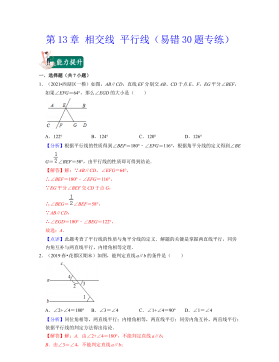
 2024-10-14 28
2024-10-14 28 -
七年级数学下册(易错30题专练)(沪教版)-第12章 实数(原卷版)VIP免费
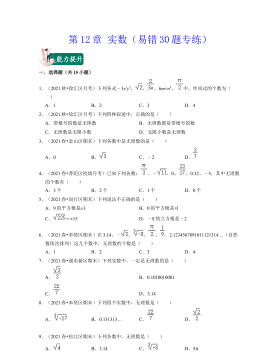
 2024-10-14 25
2024-10-14 25 -
七年级数学下册(易错30题专练)(沪教版)-第12章 实数(解析版)VIP免费
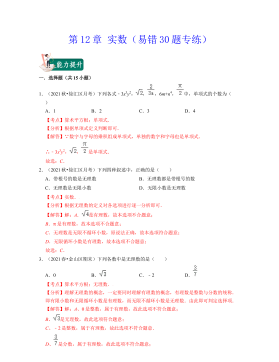
 2024-10-14 19
2024-10-14 19 -
七年级数学下册(压轴30题专练)(沪教版)-第15章平面直角坐标系(原卷版)VIP免费
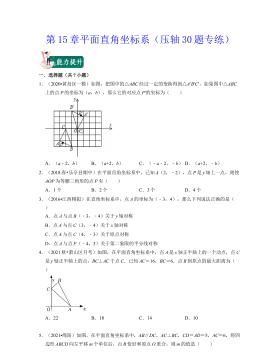
 2024-10-14 18
2024-10-14 18 -
七年级数学下册(压轴30题专练)(沪教版)-第15章平面直角坐标系(解析版)VIP免费

 2024-10-14 27
2024-10-14 27 -
七年级数学下册(压轴30题专练)(沪教版)-第14章三角形(原卷版)VIP免费

 2024-10-14 18
2024-10-14 18 -
七年级数学下册(压轴30题专练)(沪教版)-第14章三角形(解析版)VIP免费

 2024-10-14 30
2024-10-14 30 -
七年级数学下册(压轴30题专练)(沪教版)-第13章 相交线 平行线(原卷版)VIP免费
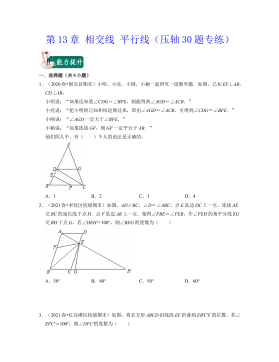
 2024-10-14 25
2024-10-14 25 -
七年级数学下册(压轴30题专练)(沪教版)-第13章 相交线 平行线(解析版)VIP免费
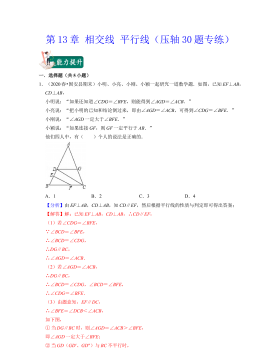
 2024-10-14 22
2024-10-14 22
作者:侯斌
分类:高等教育资料
价格:15积分
属性:104 页
大小:8.46MB
格式:PDF
时间:2025-01-09
相关内容
-

七年级数学下册(压轴30题专练)(沪教版)-第15章平面直角坐标系(原卷版)
分类:中小学教育资料
时间:2024-10-14
标签:无
格式:DOCX
价格:15 积分
-

七年级数学下册(压轴30题专练)(沪教版)-第15章平面直角坐标系(解析版)
分类:中小学教育资料
时间:2024-10-14
标签:无
格式:DOCX
价格:15 积分
-

七年级数学下册(压轴30题专练)(沪教版)-第14章三角形(原卷版)
分类:中小学教育资料
时间:2024-10-14
标签:无
格式:DOCX
价格:15 积分
-

七年级数学下册(压轴30题专练)(沪教版)-第14章三角形(解析版)
分类:中小学教育资料
时间:2024-10-14
标签:无
格式:DOCX
价格:15 积分
-

七年级数学下册(压轴30题专练)(沪教版)-第13章 相交线 平行线(原卷版)
分类:中小学教育资料
时间:2024-10-14
标签:无
格式:DOCX
价格:15 积分


